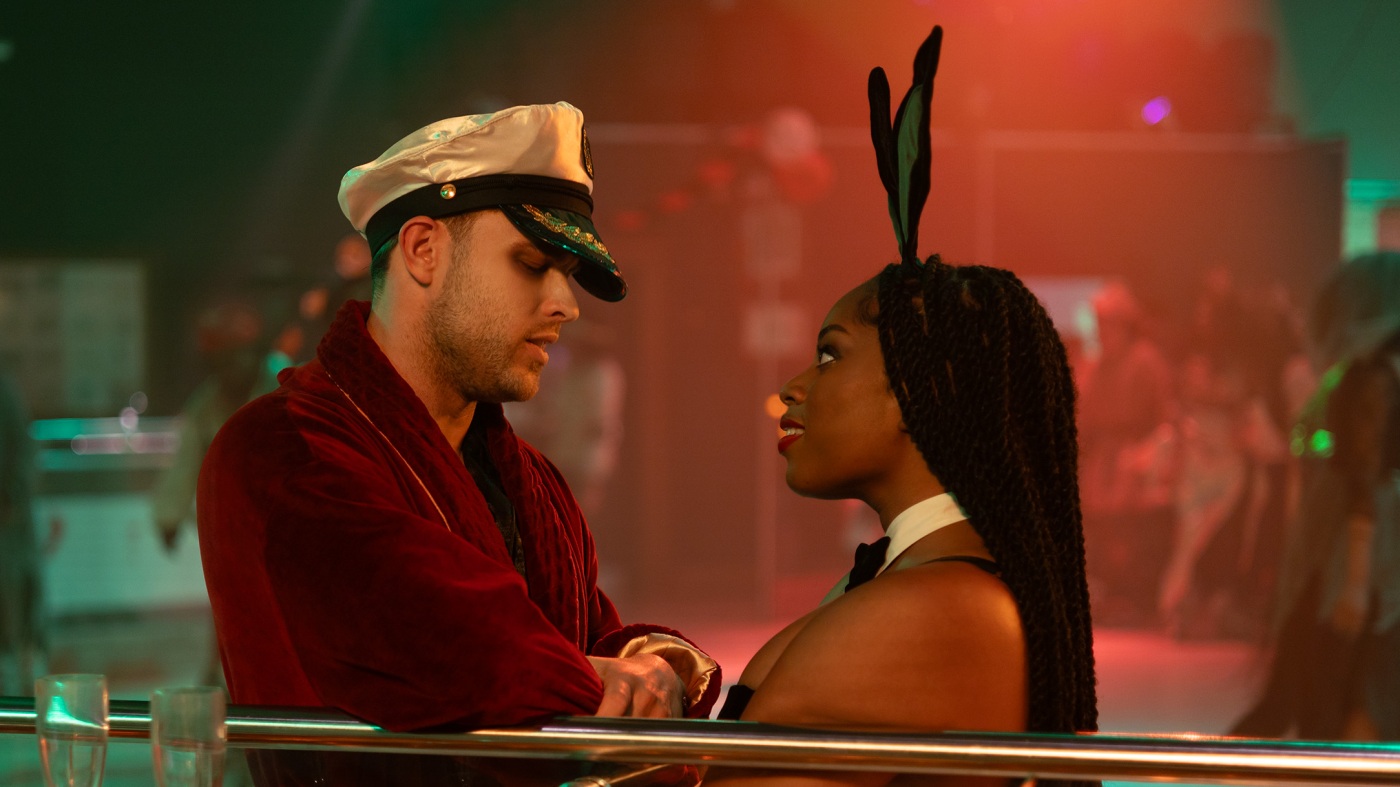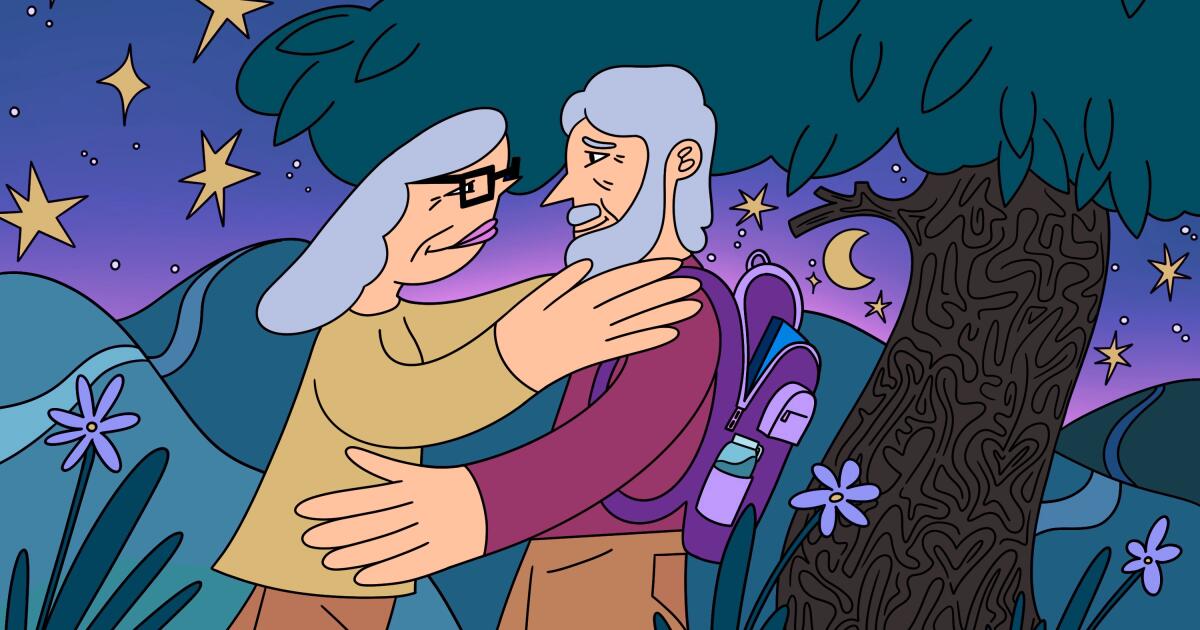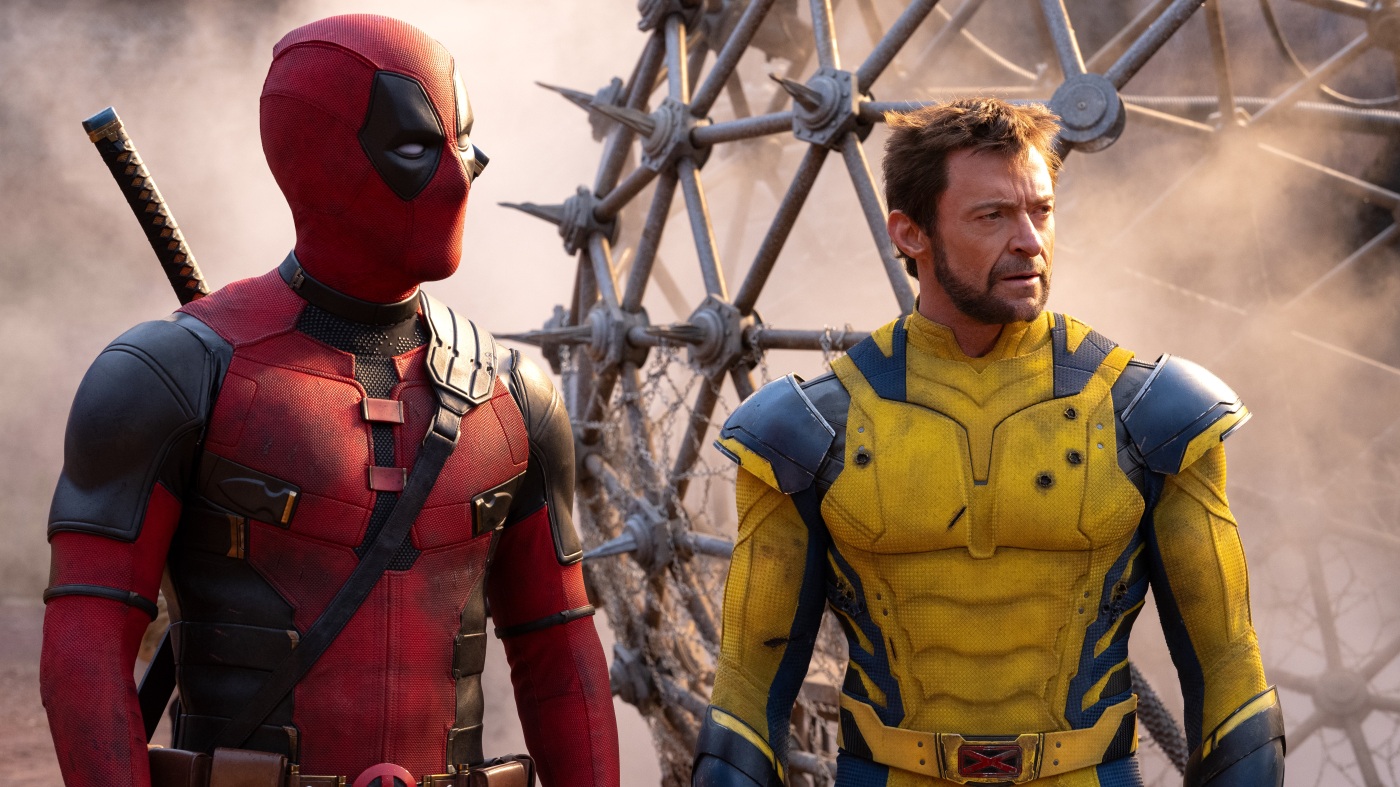Lifestyle
Queenie's second life on screen gives her more room to grow

In the episode “From Virgin to Vixen,” Queenie is in peak fun mode, until her demons begin to catch up with her.
Latoya Okuneye/Lionsgate
hide caption
toggle caption
Latoya Okuneye/Lionsgate
The new Hulu series Queenie explores the quarter-life growing pains of lonely South Londoner Queenie Jenkins.
The first of her British Jamaican family to go to university, Queenie is a struggling writer awkwardly straddling multiple worlds. An unwanted breakup with her white, longtime live-in boyfriend Tom sends her painfully reeling — spiraling into, and then climbing out of, destructive behaviors and onto a journey of growth and self-acceptance.
The show, which premiered Friday, is based on a 2019 book by Candice Carty-Williams. And with Carty-Williams at the creative helm, the novel’s strengths are immediately visible on screen: the sharp social observation, the rawness of the voice, and the specificity and conundrums of aspirational, young Black British life in the millennium.
As showrunner, Carty-Williams effectively translates and expands her vision, addressing the pain points that both riveted and rankled the book’s readers and ensuring that the creative aspects of production also make an impression. Through sight, sound and performance, Queenie creates an empathetic and irresistible portrait of a young woman’s life in multicultural-yet-divided London.
The performances bring the novel to life
As great as the production sounds and looks, it’s the performances that make Queenie’s journey really accessible on screen. The material is challenging and multi-tonal but not a performance hits a wrong note. British actor Dionne Brown embodies Queenie Jenkins inside and out in a breakout role that is a world away from her restrained supporting performance as a police detective in the Apple TV+ crime drama Criminal Record. Brown told NPR she felt drawn to the role because of how strongly she related to the novel: “my most visceral and initial reaction was just, I didn’t know that other women felt like this. I didn’t know other Black women felt like this.” So throughout taping she used the book “like a Bible.”
And though it’s her first screen acting role, hip-hop artist Bellah is bubbly and fierce as Queenie’s bestie Kyazike. As her loving and protective Jamaican grandparents, Joseph Marcell (butler Geoffrey from The Fresh Prince of Bel Air) and actress and comedian Llewella Gideon steal every scene they’re in. Pivotally, BAFTA-nominated actor Samuel Adewunmi, so powerful in the crime drama You Don’t Know Me, radiates charisma and kindness as Kyazike’s cousin Frank.
The format allows the audience to go deep
The eight-episode series format allows viewers to go deep into Queenie’s world, getting to know friends and family and helping us understand how love surrounds Queenie without her really feeling it. Where the novel can seem a bit bleak in spite of the humor, episodic TV gives Carty-Williams more room to experiment with different moods and tones. A few days before the premiere, Carty-Williams told NPR that she knew “we would need a lot more light on the screen” in the TV adaptation.

Candice Carty-Williams’ Queenie stars Dionne Brown and Bellah.
Ramona Rosales/Disney
hide caption
toggle caption
Ramona Rosales/Disney
Carty-Williams also said she felt fiercely protective bringing her first published novel to the screen. Basing Queenie’s story on her own experience coupled with second hand-horror stories from friends, “I had all those feelings and I didn’t want them to be stripped away, or watered down. The politics were important to me, the characters are important to me.” Queenie is a young woman’s story, but it’s also the manifestation of the adage that the personal is political. Queenie’s experiences lay bare the contours and consequences of England’s casual racism in every dimension of daily life. That includes, “the ways that [Queenie] was treated by people. This is at work, this is in relationships, this is in her relationship with Tom.” Carty-Williams said she was “willing to fight” to ensure that Queenie’s mental and emotional journey of finding herself in this world she saw as unfair made it to the screen intact.
Despite the production’s extensive management structure (Lions Gate, Disney’s Onyx Collective, and British Channel 4 were involved and over a dozen executives), it’s clear she succeeded. The show teems with the sometimes-painful, subtly-political observational humor and confessional motif that made the book stand out – and all the elements work well together.
Some important changes from novel to screen
Still, though faithful to the novel’s quarter-life crisis story, with the book’s most memorable thoughts and lines of dialogue making the leap almost verbatim from page to screen, the script bears some important changes. For one, Queenie’s circle includes a romantic addition – best friend Kiyazike’s cousin Frank, a friend and new love interest who appeared once briefly in the novel. Frank’s addition improves the series by addressing one of the biggest issues dogging the novel’s more ambivalent readers: Queenie’s fear and avoidance of Black men in favor of often painful encounters with white and brown men.
Queenie’s original release reflected both the pervasiveness and abuse of “rom-com” and “chick-lit” as book industry terms of art, and the delicate tightrope that Black writers walk telling stories about love, sex and race.
When Queenie debuted it appeared on best seller lists in multiple countries. Queenie won both Best Debut and Book of the Year at the British Book Awards. Carty-Williams was the first Black woman author to win the latter award.
In Britain, where Carty-Williams grew up, Queenie quickly found a fiercely loyal following — a largely female audience that loved its voice and perspective. Many of those readers were women of color, Black British women who identified fiercely with the young woman struggling to claim love, career, self worth and mental health.
But the book’s popular and critical reception was somewhat mixed in the U.S., where the author was an unknown quantity. At minimum, some audiences were discomfited by Queenie’s emotional scarring and trauma around race when they believed they were promised something lighter – the heft and trauma of the book billed as a Black Bridget Jones Diary seemed to betray its framing. While Bridget Jones’ deepest insecurities stemmed from 10 extra pounds, granny panties and two very different suitors, Queenie grapples with racism, a miscarriage and sexual trauma. And some vocal African American readers were unhappy with its handling of these heavier themes. At worst, some storylines were seen as painfully self-hating or even the product of internalized anti-Black racism.
Falling into ever more painful situations, Queenie has sex with men who talk about and treat her in demeaning, if not downright racist ways — the men she meets in apps and in the neighborhood reference her race, color, and the contours of her body as though she is a sex toy. They don’t see or aren’t that interested in her intelligence and her pain.

Gallery/Scout Press
hide caption
toggle caption
Gallery/Scout Press
Carty-William’s unflinching portrayal of Queenie’s situation is one of the novel’s most challenging aspects. Though Queenie notices and complains about the degrading approaches, she dates a series of these men and continues to long for the return of a boyfriend who seems to treat her with little regard. She seems to internalize racism and brush off the disrespect, taking it in stride as long as the men dishing it out are not Black. Even for a literary novel (which despite the comedic tone, Queenie really is) that would be hard to take in (Luster comes to mind). But that’s not how the book was positioned. Though Carty-Williams used the “Black Bridget Jones” marketing pitch to broaden the readership, she’s also said of Queenie: “She’s not Bridget Jones. She could never be.” As a result of the label, though, and the gorgeous, brightly-colored cover drawing of a Black woman with braids and hoop earrings, Black women were primed to see themselves at the center of romance-infused comedy. That’s not what they got.
Instead, the novel Queenie offers a sometimes harrowing multidimensional portrait of the dynamics of love, work and identity, mental health, and the Black immigrant experience. The love and acceptance Queenie eventually finds is hard won, and it lies not in a romantic relationship but within herself and her community. That’s a healthy choice. But every genre makes a promise, and a bait and switch in terms of reader expectations can feel like erasure.
Exploring critically important topics in the book and on screen
That said, as Carty-Williams emphasizes, discomfiting or not, Queenie’s experience is worth delving into. If it’s hard to reconcile Queenie’s sharp insight and her self-destructive actions, it’s also true that Queenie navigates a world that routinely doesn’t see, or fetishizes and even villainizes, her. Exploding the stereotype of a “strong Black woman,” with intense vulnerability, parts are hard to watch, but through her experimentation and misadventures, both the novel and the series explore essential topics: the racial and gender dynamics and politics of consent and desirability, and the rippling effects of domestic partner abuse. It is hard to watch her covet white attention and approval even when it hurts her, but it’s something that many Black women have been through.

Dionne Brown as Queenie in a scene with her best friend Kyazike, played by Bellah.
Latoya Okuneye//Disney
hide caption
toggle caption
Latoya Okuneye//Disney
A big challenge for the screen adaptation is that despite therapy, Queenie’s deeply rooted fear of Black men doesn’t have a resolution, or much deeper exploration in the original text. In a novel about self reflection, self-acceptance and growth, this is hard to reconcile. The series does better. The racial dimensions of Queenie’s pain and fears were at the center of some online discourse in 2019 and, in the leadup to the premiere, some with knowledge of the story raised similar questions on social media in reaction to the Queenie trailer.
When talking with NPR for this piece, Carty-Williams pointed out that when readers have been in conversation about her debut, they tend to ask how Queenie did what she did. She pushes back wondering why the onus is on the woman rather than asking why men behave how they do toward Queenie. She also disclosed that the series allowed her to better resolve Queenie’s difficulties with men in her community partly, but not exclusively, through her relationship with her best friend’s cousin Frank. Carty-Williams said that this exploration was inspired both by conversations with readers and by her own maturation. Now in her 30s, she says she better understands attachment disorder, and how fears and triggers manifest, than when she started writing the novel at 26. In this way, the story of the making of Queenie-the-series has a happier ending — giving Queenie more room to grow.

Lifestyle
'Wait Wait' for July 27, 2024: With Not My Job guest Kathleen Hanna

Kathleen Hanna of The Julie Ruin performs onstage at the 2016 Panorama NYC Festival – Day 2 at Randall’s Island on July 23, 2016 in New York City. (Photo by Nicholas Hunt/Getty Images)
Nicholas Hunt/Getty Images/Getty Images North America
hide caption
toggle caption
Nicholas Hunt/Getty Images/Getty Images North America
This week’s show was recorded in Chicago with host Peter Sagal, judge and scorekeeper Bill Kurtis, Not My Job guest Kathleen Hanna and panelists Meredith Scardino, Peter Grosz, and Mo Rocca Click the audio link above to hear the whole show.
Who’s Bill This Time
Momala Takes Over; Assigned Seats Are Back; And The Heat Is On
The Olympic Torch Reporch
Our Summer Olympics Preview
Bluff The Listener
Our panelists tell three stories about someone committing an office faux pas, only one of which is true.
Not My Job: We quiz Bikini Kill’s Kathleen Hanna on Hanna-Barbera
Punk icon Kathleen Hanna plays our game called, “Kathleen Hanna Meet Hannah-Barbera.” Three questions about the animation studio.
Panel Questions
Hide Your Receipts; VR Meets ER; Avocado Apologies
Limericks
Bill Kurtis reads three news-related limericks: Situation Room Cocktails; Burrito Bird; Hopped Up Sharks
Lightning Fill In The Blank
All the news we couldn’t fit anywhere else
Predictions
Our panelists predict what will be the big story out of the Paris Olympic Games
Lifestyle
L.A. Affairs: At 77, I had a crush on my best friend’s widower. Did he feel the same way?

At 77, I had given up. After two failed marriages and years of unsuccessful dating, I accepted what seemed to be my fate: single for almost 40 years and single for however many remained. You don’t get it all, I told myself. I was grateful for family, friends and work. Life settled into what felt like order.
Until Ty.
As the husband of my best friend, he was no stranger, but he was usually peripheral. Then 10 years ago, my friend got lung cancer. I watched during visits, stunned at how nurturing Ty could be, taking care of her even though they had separated years before at her request.
After she died, Ty and I stayed in touch sporadically: a surprise sharing of his second granddaughter a year after we scattered my friend’s ashes, an invitation to the launch of my book a year later. Ty attended, hovering in the back, emerging after everyone left to attentively help load my car.
Two more years passed. During quiet moments, I remembered his sweetness. I also remembered his handsome face and long, tall body. Confused about what I wanted, I texted Ty, who’s an architect, under the guise of purchasing a tree for my backyard.
We spent an afternoon at the nursery, laughing, comparing options and agreeing on a final selection. When the tree arrived, I emailed a photo. He emailed a thank you.
Another three years passed, broken only by news of his third granddaughter and my memories of how good it felt to be with him. Alert to his attentiveness, but unsettled by both his remove and my growing interest, I risked reaching out again, this time about remodeling my garage.
Ty spent several hours at my house making measurements, checking the foundation and sharing pictures of his home in Topanga. His sketches for the garage arrived two weeks later via email.
I was grateful for his help but unsure over what sort of friendship we were developing, at least from his point of view. I, however, was clear. I wanted him to wrap his long arms around me, tell me sweet things and make me his.
Instead, I sent a gift card to a Topanga restaurant to thank him for his drawings.
“Maybe we should spend it together,” he texted.
We dined in the dusk of late summer. Our talk was easy. Discomfort lay in the unspoken. Anxious for clarity, I repeatedly let my hand linger near the candle flickering in the middle of our table. It remained untouched.
And that was as far as I was willing to go. I refused to be any more forward, having already compromised myself beyond my comfort level with what seemed, at least to me, embarrassingly transparent efforts to indicate my interest. Not making the first move was very important. If a man could not reach out, if he didn’t have the self-confidence to take the first step, he would not, I adamantly felt, be a good partner for me.
Two weeks later, Ty did email, suggesting an early evening hike in Tuna Canyon in Malibu. The setting was perfect. Sun sparkled off the ocean. A gentle breeze blew. We climbed uphill for sweeping coastal vistas and circled down to the shade of live oaks, touching only when he took my hand to steady me where the path was slippery. At the end of the trail, overlooking the juncture between the mountains and the sea, we stood opposite each other and talked animatedly for almost an hour, both of us reluctant to part.
Our conversation was engaging, but my inner dialogue was louder. When, I kept thinking, is this man going to suggest we continue the evening over dinner? We didn’t have to go out. We could eat at his house. It was 7 p.m., for God’s sake. Passing hikers even stopped to remark on our matching white hair and how well they thought we looked together. It was like a movie scene where the audience is yelling, “Kiss her, kiss her,” rooting for what they know is going to happen while the tension becomes almost unbearable. But bear it I did.
Each of us ate alone.
A few weeks later, at his suggestion, we were back at Tuna Canyon. This time Ty did invite me to end the evening at his house. Sitting close on his couch, but not too close, we drifted toward each other in the darkening room. His shoulder brushed mine reaching for his cup of coffee. My hip pressed his as I leaned in for my tea. Slowly, sharing wishes and hopes for our remaining years, we became shadows in the light of the moon. And in that darkness, in that illuminated space, he reached out.
This reticent man, this man who was so slow to move toward me, this sensitive man who hid himself behind layers so opaque I was unsure of his interest, released all that he had inside him.
“I wanted you,” Ty repeated again and again. “I was afraid of ruining things. You were her best friend. I didn’t want to lose your friendship.”
Our pent-up tension exploded.
Stunned and thrilled, I leaned into the space he opened.
Three years later, it is a space we continue to share: a place where neither of us has given up, a place where he wraps me in his long arms, a place we hold carefully against our diminishing days.
The author is the owner of a preschool in Venice as well as a psychotherapist, photographer and writer. Her first book, “Naked in the Woods: My Unexpected Years in a Hippie Commune,” was published in 2015. Her newest manuscript, “Bargains: A Coming of Aging Memoir Told in Tales,” is seeking a publisher. She lives in Mar Vista and can be found at margaretgrundstein.com, Instagram @margwla, Medium @margaretgrundstein and Substack @mgrundstein.
L.A. Affairs chronicles the search for romantic love in all its glorious expressions in the L.A. area, and we want to hear your true story. We pay $400 for a published essay. Email LAAffairs@latimes.com. You can find submission guidelines here. You can find past columns here.
Lifestyle
'Deadpool & Wolverine' is a self-cannibalizing slog

Ryan Reynolds stars as Deadpool and Hugh Jackman as Wolverine in an odd-couple action hero pairing.
Jay Maidment/20th Century Studios
hide caption
toggle caption
Jay Maidment/20th Century Studios
When Fox Studios released the first Deadpool movie back in 2016, it played like an irreverently funny antidote to our collective comic-book-movie fatigue. Wade Wilson, or Deadpool, was a foul-mouthed mercenary who obliterated his enemies and the fourth wall with the same gonzo energy.
Again and again, Deadpool turned to the camera and mocked the clichés of the superhero movie with such deadpan wit, you almost forgot you were watching a superhero movie. And Ryan Reynolds, Hollywood’s snarkiest leading man, might have been engineered in a lab to play this vulgar vigilante. I liked the movie well enough, though one was plenty; by the time Deadpool 2 rolled around in 2018, all that self-aware humor had started to seem awfully self-satisfied.
Now we have a third movie, Deadpool & Wolverine, which came about through some recent movie-industry machinations. When Disney bought Fox a few years ago, Deadpool, along with other mutant characters from the X-Men series, officially joined the franchise juggernaut known as the Marvel Cinematic Universe.
That puts the new movie in an almost interesting bind. It tries to poke fun at its tortured corporate parentage; one of the first things Deadpool says is “Marvel’s so stupid.” But now the movie also has to fit into the narrative parameters of the MCU. It tries to have it both ways: brand extension disguised as a satire of brand extension.

It’s also an odd-couple comedy, pairing Deadpool with the most famous of the X-Men: Logan, or Wolverine, the mutant with the unbreakable bones and the retractable metal claws, played as ever by a bulked-up Hugh Jackman.
The combo makes sense, and not just because both characters are Canadian. In earlier movies, Deadpool often made Wolverine the off-screen butt of his jokes. Both Deadpool and Wolverine are essentially immortal, their bodies capable of self-regenerating after being wounded. Both are tormented by past failures and are trying to redeem themselves. Onscreen, the two have a good, thorny chemistry, with Jackman’s brooding silences contrasting nicely with Reynolds’ mile-a-minute delivery.
I could tell you more about the story, but only at the risk of incurring the wrath of studio publicists who have asked critics not to discuss the plot or the movie’s many, many cameos. Let’s just say that the director Shawn Levy and his army of screenwriters bring the two leads together through various rifts in the multiverse. Yes, the multiverse, that ever-elastic comic-book conceit, with numerous Deadpools and Wolverines from various alternate realities popping up along the way.

I suppose it’s safe to mention that Matthew Macfadyen, lately of Succession, plays some kind of sinister multiverse bureaucrat, while Emma Corrin, of The Crown, plays a nasty villain in exile. It’s all thin, derivative stuff, and the script’s various wink-wink nods to other shows and movies, from Back to the Future to Furiosa to The Great British Bake Off, don’t make it feel much fresher. And Levy, who previously directed Reynolds in the sci-fi comedies Free Guy and The Adam Project, doesn’t have much feel for the splattery violence that is a staple of the Deadpool movies. There’s more tedium than excitement in the characters’ bone-crunching, crotch-stabbing killing sprees, complete with corn-syrupy geysers of blood.

For all its carnage, its strenuous meta-humor and an R-rated sensibility that tests the generally PG-13 confines of the MCU, Deadpool & Wolverine does strive for sincerity at times. Some of its cameos and plot turns are clearly designed to pay tribute to Fox’s X-Men films from the early 2000s.
As a longtime X-Men fan myself, I’m not entirely immune to the charms of this approach; there’s one casting choice, in particular, that made me smile, almost in spite of myself. It’s not enough to make the movie feel like less of a self-cannibalizing slog, though I suspect that many in the audience, who live for this kind of glib fan service, won’t mind. Say what you will about Marvel — I certainly have — but it isn’t nearly as stupid as Deadpool says it is.

-

 World1 week ago
World1 week agoOne dead after car crashes into restaurant in Paris
-

 Midwest1 week ago
Midwest1 week agoMichigan rep posts video response to Stephen Colbert's joke about his RNC speech: 'Touché'
-

 News1 week ago
News1 week agoVideo: Young Republicans on Why Their Party Isn’t Reaching Gen Z (And What They Can Do About It)
-

 Movie Reviews1 week ago
Movie Reviews1 week agoMovie Review: A new generation drives into the storm in rousing ‘Twisters’
-

 News1 week ago
News1 week agoIn Milwaukee, Black Voters Struggle to Find a Home With Either Party
-

 Politics1 week ago
Politics1 week agoFox News Politics: The Call is Coming from Inside the House
-

 News1 week ago
News1 week agoVideo: J.D. Vance Accepts Vice-Presidential Nomination
-

 World1 week ago
World1 week agoTrump to take RNC stage for first speech since assassination attempt
















